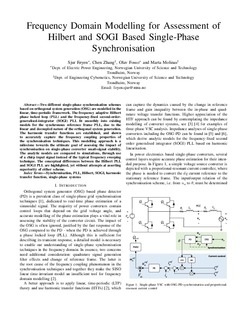| dc.contributor.author | Føyen, Sjur | |
| dc.contributor.author | Fosso, Olav B | |
| dc.contributor.author | Zhang, Chen | |
| dc.contributor.author | Molinas Cabrera, Maria Marta | |
| dc.date.accessioned | 2020-02-11T11:51:14Z | |
| dc.date.available | 2020-02-11T11:51:14Z | |
| dc.date.created | 2020-01-08T13:07:21Z | |
| dc.date.issued | 2019 | |
| dc.identifier.isbn | 978-1-7281-4878-6 | |
| dc.identifier.uri | http://hdl.handle.net/11250/2641018 | |
| dc.description.abstract | Two different single-phase synchronisation schemes based on orthogonal system generation (OSG) are modelled in the linear, time-periodic framework. The frequency adaptive Hilbert phase locked loop (PLL) and the frequency-fixed second-order-generalised-integrator (SOGI) PLL fit smoothly into existing models for the synchronous reference frame PLL, due to the linear and decoupled nature of the orthogonal system generation. The harmonic transfer functions are established, and shown to accurately capture the frequency coupling properties of the synchronisation techniques. This modelling approach is a milestone towards the ultimate goal of assessing the impact of synchronisation on single-phase converter small-signal stability. The analytic models are compared to simulations, through use of a chirp input signal instead of the typical frequency sweeping technique. The conceptual differences between the Hilbert PLL and SOGI PLL are highlighted, yet without attempts at asserting superiority of either scheme. | nb_NO |
| dc.language.iso | eng | nb_NO |
| dc.publisher | Institute of Electrical and Electronics Engineers (IEEE) | nb_NO |
| dc.relation.ispartof | Proceeding 45th Annual Conference of the IEEE Industrial Electronics Society - IECON 2019 | |
| dc.title | Frequency Domain Modelling for Assessment of Hilbert and SOGI Based Single-Phase Synchronisation | nb_NO |
| dc.type | Chapter | nb_NO |
| dc.description.version | acceptedVersion | nb_NO |
| dc.identifier.doi | https://doi.org/10.1109/IECON.2019.8926656 | |
| dc.identifier.cristin | 1768547 | |
| dc.relation.project | Norges forskningsråd: 257626 | nb_NO |
| dc.description.localcode | © 2019 IEEE. Personal use of this material is permitted. Permission from IEEE must be obtained for all other uses, in any current or future media, including reprinting/republishing this material for advertising or promotional purposes, creating new collective works, for resale or redistribution to servers or lists, or reuse of any copyrighted component of this work in other works. | nb_NO |
| cristin.unitcode | 194,63,20,0 | |
| cristin.unitcode | 194,63,25,0 | |
| cristin.unitname | Institutt for elkraftteknikk | |
| cristin.unitname | Institutt for teknisk kybernetikk | |
| cristin.ispublished | true | |
| cristin.fulltext | postprint | |
| cristin.qualitycode | 1 | |
